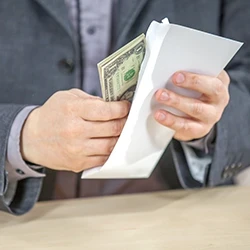Driving with a suspended license is a serious offense that can lead to jail time, hefty fines, and extended suspension periods, depending on the state and circumstances. In some cases, penalties can be as severe as one year in jail and fines up to $2,500.
Despite these risks, many drivers unknowingly operate a vehicle with a suspended license, putting themselves at risk of criminal charges.
Understanding the legal consequences, how to check your license status, and the steps to reinstate your driving privileges is essential to staying compliant with traffic laws.
This article breaks down the penalties for driving with a suspended license, how to determine your current license status, and the process for reinstatement to help you avoid further legal trouble and get back on the road legally.
Quick Summary
- Obtain a copy of your driving record through your state's Department of Motor Vehicles (DMV). This can typically be done online, in person, or by mail. Your driving record will indicate whether your license is valid, suspended, or revoked.
- Many states offer online portals where you can check your license status by entering personal information such as your driver's license number and date of birth.
- If online services are unavailable or you prefer direct communication, call or visit your local DMV office. They can provide information regarding your license status and any steps needed for reinstatement.
- The NDR maintains records of drivers whose licenses have been suspended or revoked across the United States. You can request information from the NDR to see if you are listed in their database.
Why A License May Be Suspended?
A license may be suspended due to several reasons, such as not paying traffic fines, driving while under the influence of drugs or alcohol, accumulating too many points on your license, traffic violation, a large number of traffic tickets, and failing to complete court-ordered programs or classes.
"One of the reasons you might be unsure of your driver's license status is that you might be unaware of the violation that led to the suspension."
- Michael Simmrin, Trial Lawyer at Simmrin Law Group
Penalties For Driving With A Suspended License

- 6 months in jail, and
- $1,000 in fines.
If you commit a second offense within five years, the consequences will be more severe. The punishment for the offense can range from:
- 5 days to 1 year in jail
- fines ranging from $500 to $2,000 will be imposed.
If you get caught driving with a suspended license, your suspension period may be prolonged, so you'll have to wait longer to regain your driving privileges. However, it is important to note that contesting the charges of driving on a suspended license is possible. One common defense is that the DMV did not inform you of the suspension and did not know about it.
Is Your Driver’s License Suspended? Here’s How to Find Out and What to Do Next
Discovering that your driver’s license is suspended can be a stressful situation, but taking immediate action is crucial to avoid further penalties.
Whether your suspension was due to unpaid fines, traffic violations, or administrative errors, knowing how to check your license status and take the right steps toward reinstatement is essential.
Below is a step-by-step guide to help you determine if your license is suspended and what actions you should take next.
Immediate Steps If Your License Is Suspended
If you suspect your license may be suspended, taking quick and responsible action can help prevent further complications.
Here’s what you should do right away:
- Stop Driving Immediately – If your license is suspended, continuing to drive can result in additional fines, extended suspension periods, and even jail time in some states. Avoid unnecessary legal trouble by resolving the issue before getting back on the road.
- Contact Your State DMV – Each state’s Department of Motor Vehicles (DMV) can provide details about why your license was suspended and what steps you need to take to reinstate it. You can visit their website, call their office, or go in person for assistance.
- Consult an Attorney if Needed – If you believe your suspension was unjust or if you’re facing legal consequences, an experienced traffic attorney can guide you through the appeals or reinstatement process.
How To Check If A Driver’s License Is Suspended?

1. Online
Many state Departments of Motor Vehicles (DMVs) offer online services to check your license status [2]. For instance, the New York DMV provides a "My License, Permit, or ID" service through their MyDMV portal.
Pros:
- Convenient and accessible 24/7.
- Immediate results.
Cons:
- May require account creation.
- Not all states offer comprehensive online services.
Estimated Processing Time:
Typically immediate upon verification.
Fees: Vary by state; for example, California charges $2 for an online driver record request
2. DMV Office
Visiting a local DMV office allows you to request your driving record directly. In California, you can complete an INF 1125 form to obtain your record [2].
- Access to official, certified records.
- Opportunity to address other DMV-related matters simultaneously.
Cons:
- Potential long wait times.
- Limited to business hours.
Estimated Processing Time:
Varies; typically within the same visit.
Fees: Generally higher than online requests; for example, California charges $5 for in-person requests
3. E-mail
You can request your driving record by mail by sending a completed form to your state's DMV. For instance, in South Carolina, you can complete a Request for Driver Information (Form MV-70) and mail it with the required fee.
Pros:
- No need to visit an office in person.
- Access to official, certified records.
Cons:
- Longer processing times.
- Risk of mail delays or losses.
Estimated Processing Time:
Several days to weeks, depending on postal service and DMV processing times.
Fees: Vary by state; for example, South Carolina charges $6 for a mailed request
4. Insurance Company
Some insurance companies can inform you if your license has been suspended, as it may affect your policy.
Pros:
- Convenient if you have an existing relationship.
- May provide additional insights into how a suspension affects your insurance.
Cons:
- Not all companies offer this service.
- Information may not be as up-to-date as DMV records.
Estimated Processing Time:
Varies; typically within a few business days.
Fees: Generally none, but it's best to confirm with your provider.
By understanding these methods, their benefits, and potential drawbacks, you can choose the most suitable approach to verify your driver's license status and ensure compliance with state regulations.
What To Do If Your License Is Suspended?

Reinstating Your Suspended License
If your license is suspended, you’ll need to go through a reinstatement process before you can legally drive again.
Common steps include paying reinstatement fees, obtaining proof of financial responsibility, completing educational courses, and possibly retaking driving examinations [4].
The exact requirements vary by state, but the following steps are commonly required:
1. Identify the Cause of Suspension
Before you can reinstate your license, you must determine why it was suspended.
Common reasons include:
- Unpaid fines or traffic tickets
- DUI or reckless driving convictions
- Accumulation of too many driving points
- Failure to maintain auto insurance
2. Resolve the Suspension Issue
Depending on the reason for your suspension, you may need to:
- Pay outstanding fines or court fees
- Complete a defensive driving course (if required by your state)
- Provide proof of car insurance (some states require SR-22 or FR-44 forms)
3. Gather Necessary Documents
To reinstate your license, you may be required to submit paperwork, including:
- Proof of completion for any required courses
- Insurance documents (SR-22/FR-44 forms if applicable)
- A reinstatement application form
4. Pay the Reinstatement Fees
Reinstatement fees vary by state and violation type. Some examples include:
- Georgia: Fees range from $25 for child support non-compliance to $410 for third-offense points violations.
- Illinois: A $70 reinstatement fee per suspension is required.
- Michigan: The reinstatement fee is $125, with potential additional charges.
- Virginia: Fees range between $145 and $220, depending on the offense.
5. Submit Your Reinstatement Application
Once you’ve met all requirements, you can submit your reinstatement application online, in person at the DMV, or by mail.
- Processing Time: Most applications are processed within several business days once all conditions are met.
Reinstatement Timeframes: How Long Does It Take?
The time required to reinstate your license depends on several factors, including the severity of the violation and state-specific rules.
- Completing required courses: Can take a few days to a few weeks.
- Processing reinstatement applications: Typically several business days, depending on DMV workload.
- “Immediate Threat” Suspensions: These are indefinite suspensions requiring a legal appeal and, in some cases, a hearing before the Board of Appeals.
If your license was suspended due to an “immediate threat” violation, you may need to retake driving tests upon a successful appeal before regaining full driving privileges.
A suspended license can impact your daily life, from limiting job opportunities to increasing insurance premiums and legal troubles.
Taking proactive steps to check your license status, resolve any outstanding issues, and follow the correct reinstatement procedures is the best way to get back on the road legally.
Related Article
: 7 Most Common Causes of Sideswipe Accidents
See all related personal injury lawsuits our lawyer covered so far.
FAQs
1. What Information Is On The Record?
The information on the records includes information about the driver's licensing history, social security number, traffic violations, accidents, and any driver's license suspensions or revocations.
2. Why Would I Want To Find Out If My Driver’s License Is Suspended?
You want to find out if your driver's license is suspended because driving with a suspended license can result in fines, further license suspension, or even criminal charges.
3. Is License Revocation The Same Thing As A Suspension?
No, license revocation is not the same thing as a suspension. A license suspension means you cannot drive for a limited time, whereas revocation means losing your driver's license permanently. Revocation is usually given for more severe offenses, such as multiple DUI convictions or leaving the scene of an accident.
Is Your Driver License Suspended?
If you're facing a license suspension or other traffic violations, it can be helpful to seek the advice of an experienced attorney. Our law firm, Schmidt & Clark, LLP provides legal assistance to clients dealing with various legal matters.Among our specialty areas is assisting clients facing driver's license suspensions. By working with us, we can help you address the issue and ensure you can regain your driver's license while complying with all legal requirements and ensuring public safety.
References:
- https://www.dmv.ca.gov/portal/file/request-for-your-own-driver-license-identification-card-dl-id-or-vehicle-vessel-registration-vr-information-record-inf-1125-pdf/
- https://www.dmv.ca.gov/portal/customer-service/request-vehicle-or-driver-records/online-driver-record-request/
- https://law.justia.com/codes/california/2005/veh/14600-14611.html
- https://www.dmv.ca.gov/portal/uploads/2020/07/DS-326-R6-2020-AS-WWW.pdf

 Published by
Published by 

